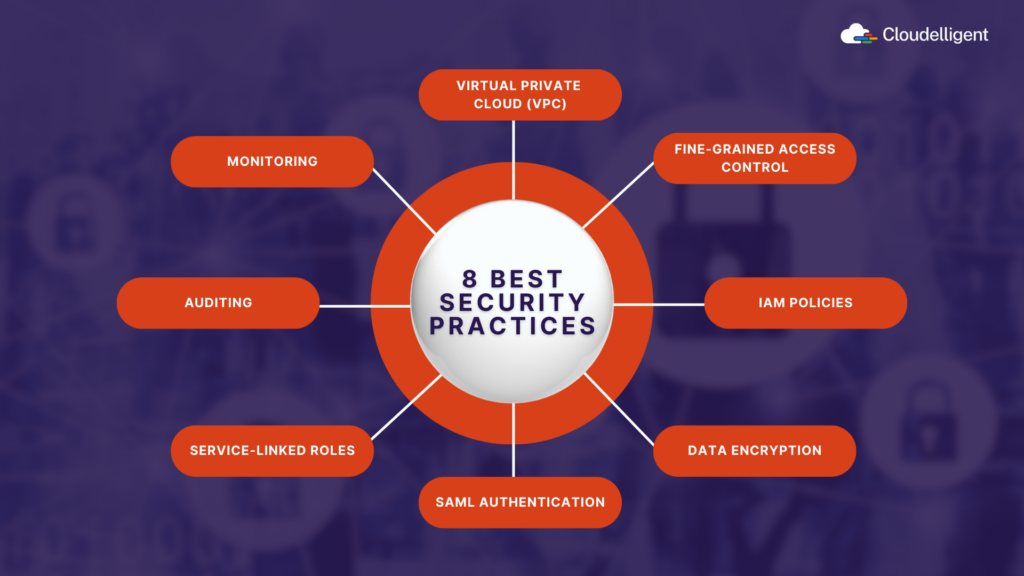Imagine unlocking powerful search and analytics capabilities with Amazon OpenSearch Service, only to find security gaps threatening your data integrity and privacy. In today’s digital landscape, where cyber threats are more sophisticated than ever, securing your OpenSearch Service isn’t just a best practice; it’s a business imperative. Whether you’re managing sensitive customer data, proprietary business insights, or public-facing applications, the stakes are too high to leave vulnerabilities unchecked.
This blog post will delve into the top 8 best practices to fortify your Amazon OpenSearch Service cluster and ensure the confidentiality, integrity, and availability of your data. By implementing these strategies, you can significantly reduce the risk of unauthorized access, data loss, and other security threats.
The Need for Data Security in OpenSearch Services
When businesses prioritize security measures, they create a foundation for trust, stability, and growth. Protecting confidential information not only prevents potential disruptions but also strengthens a company’s reputation, enhances client confidence, and supports long-term success.
Using Amazon OpenSearch Service can make your website data easily discoverable through its search and analytics features. However, it also introduces potential cybersecurity risks, as attackers may exploit vulnerabilities such as:
- Unauthorized Access: Attackers can exploit vulnerabilities to gain access to sensitive data stored in OpenSearch.
- Data Manipulation and Corruption: Without strict access controls, data could be altered, leading to compromised information integrity.
- Malware and Ransomware Attacks: Vulnerable systems may be targeted with malicious software, risking data loss and operational downtime.
- Unlawful Monitoring and Tracking: Insufficient auditing may allow attackers to observe or track user activities undetected.
8 Proven Strategies to Safeguard Your OpenSearch Data

Figure 1: 8 Best Security Practices for Amazon OpenSearch Service
1. Deploy Domains within a VPC
To establish strong security for Amazon OpenSearch Service, you can start by configuring network-level security through a Virtual Private Cloud (VPC). A VPC isolates your OpenSearch Service domain from public internet access and only allows requests from within your private AWS network. This setup ensures that OpenSearch communicates securely with other services within the VPC which eliminates the need for an internet gateway, NAT device, or VPN.
By leveraging OpenSearch Service-Managed VPC Endpoints (via AWS PrivateLink), you can gain even greater control, as these endpoints prevent public exposure. This helps keep sensitive data protected within a secure network layer and reduces the risk of external threats. Deploying OpenSearch within a VPC not only enhances security but also allows flexible configurations, balancing the need for accessibility and robust data protection.
2. Implement Fine-Grained Access Control
Fine-grained access control in Amazon OpenSearch Service provides robust data security by granting precise permissions based on user identity and roles. With this control, you can manage data visibility at multiple levels. This enables specific searches or restricts sensitive data access based on who makes the request. Key features include:
- Role-based Access Control: Users can be assigned roles with permissions tailored to access only the resources needed, protecting sensitive data from unauthorized users.
- Security at the Index, Document, and Field Level: By setting restrictions at various data levels, you can ensure that only authorized personnel can view or modify certain parts of the data. This control is invaluable for industries handling sensitive or regulated data, as it limits exposure risk.
- OpenSearch Dashboards Multi-tenancy: Different users can securely view tailored dashboards which enables multiple teams to access and analyze relevant data without cross-viewing or overlapping on sensitive information.
- HTTP Basic Authentication: OpenSearch and OpenSearch Dashboards use basic authentication to confirm user identity, ensuring only authenticated users interact with these services. This prevents unauthorized access to the data stored within OpenSearch.
Acting as a “gatekeeper,” implementing fine-grained access control empowers you to manage user permissions confidently, regulate data visibility, and minimize risks related to unauthorized data exposure within Amazon OpenSearch. This added layer of security ensures that only the right users have access to sensitive information and reduces potential vulnerabilities.
3. Set Up Identity and Access Management (IAM) Policies
IAM policies enhance Amazon OpenSearch Service security by controlling who can access resources and what actions they can perform. These policies enforce the “least privilege” principle, meaning users and applications only have the permissions necessary to complete tasks. This helps to reduce the potential for unauthorized access.
Key security measures implemented through IAM policies include:
- Signed Requests: By making and signing requests with AWS SDKs, OpenSearch users can prevent unauthorized access. Signed requests add a layer of security that validates user actions to the service.
- API Permissions Reference: OpenSearch offers API permissions for setting access controls, allowing administrators to define user-specific permissions.
- AWS Managed Policies: Pre-configured AWS-managed policies simplify permissions management and ensure best practices. For greater customization, user-defined policies can further minimize access permissions.
- Cross-Service Confused Deputy Prevention: To prevent unauthorized access when OpenSearch interacts with other AWS services, AWS uses safeguards like aws:SourceArn and aws:SourceAccount. These conditions limit permissions, protecting OpenSearch from external threats.
This setup fortifies Amazon OpenSearch Service security by ensuring only authorized actions and access points are permitted.
4. Implement Data Encryption
Data encryption in Amazon OpenSearch Service protects sensitive information both at rest and in transit which helps prevent unauthorized access and breaches.
- Encryption of Data at Rest: OpenSearch Service uses AWS Key Management Service (KMS) to automatically encrypt data at rest. This encryption secures indexes (including UltraWarm storage), logs, swap files, and automated snapshots, using the Advanced Encryption Standard (AES-256). Although manual snapshots, slow logs, and error logs aren’t encrypted by default, they can be encrypted through S3-managed or KMS keys for added security.
- Node-to-Node Encryption: Ensuring secure data exchange between OpenSearch nodes, this feature applies Transport Layer Security (TLS 1.2) to all communications within the VPC. This setup maintains encrypted data transfers between nodes, even for traffic arriving over HTTPS, ensuring data confidentiality across the cluster. Enabling node-to-node encryption is also required if fine-grained access control is active, providing an extra layer of internal security.
These encryption measures safeguard OpenSearch data from external threats and enhance compliance with data protection standards.
Curious about enhancing your data security strategies? Explore our blog, Top 5 Amazon S3 Security Strategies to Shield Your Data, for practical tips to safeguard your cloud storage.
5. Enable SAML Authentication for OpenSearch Dashboards
Security Assertion Markup Language (SAML) enables single sign-on (SSO) functionality, allowing users to log into OpenSearch Dashboards using their organization’s existing identity provider. This streamlines access while improving security by reducing the need for multiple passwords.
Below are the key authentication options you can implement for improved user access control:
- IAM Identity Center Support: IAM Identity Center streamlines user access management across AWS accounts and services by using SAML-based SSO. This makes it easier to securely manage and scale access to OpenSearch Dashboards.
- Amazon Cognito Authentication: With Amazon Cognito, you can authenticate users for OpenSearch Dashboards through social identity providers or custom login flows. This gives administrators more flexibility while ensuring secure and user-friendly access.
Enabling SAML for OpenSearch Dashboards is a crucial security best practice because it simplifies user authentication while enhancing control over access. This approach boosts both security and operational efficiency and allows you to maintain strict oversight over who can view and modify critical data.
6. Use Service-Linked Roles for Amazon OpenSearch Service
Amazon OpenSearch Service utilizes AWS Identity and Access Management (IAM) service-linked roles to simplify permissions management and improve security. These predefined roles automatically grant the necessary permissions for OpenSearch Service to interact with other AWS services which minimizes manual configurations. The roles include:
- VPC Domain Creation Role: This role enables OpenSearch Service to create domains with a VPC, ensuring secure connectivity for OpenSearch domains.
- Collection Creation Role: This role allows OpenSearch Serverless to publish metrics to CloudWatch, enabling administrators to manage and monitor serverless data collections.
- Pipeline Creation Role: This role is used by OpenSearch Ingestion to create secure data pipelines within a VPC and publish CloudWatch metrics.
By using service-linked roles, you reduce security risks and ensure only authorized services can access critical resources, supporting the principle of least privilege. This practice helps secure and streamline OpenSearch setup while enhancing overall service security.
7. Set Up Audit Logs
Audit logs in Amazon OpenSearch Service help track and monitor user activities, such as login attempts, data changes, and query requests, providing crucial visibility into system actions.
- Enable Audit Logs: Audit logs track all activities, such as user access, changes to the OpenSearch cluster, authentication attempts, index modifications, and search queries. These logs can be stored in Amazon S3 for long-term retention and analysis. For better visibility, it’s important to customize the audit log configuration based on your organization’s needs.
- Leverage CloudTrail: AWS CloudTrail integration helps monitor management actions on OpenSearch resources. It captures API calls from the OpenSearch console, CLI, or SDK, allowing admins to track who made changes, when, and from which IP address. This helps identify unauthorized actions and mitigate risks. CloudTrail events can be continuously delivered to an S3 bucket for ongoing monitoring.
Together, audit logs and CloudTrail ensure that you have full visibility into OpenSearch activity, which aids in maintaining security, accountability, and compliance across your OpenSearch environment.
8. Regularly Monitor and Audit Access
Maintaining the security of your Amazon OpenSearch Service environment requires continuous vigilance. By leveraging the following AWS tools, you can proactively detect anomalies, validate policies, and assess your deployment against security best practices.
- Monitor Amazon CloudWatch Metrics: It’s important to regularly monitor CloudWatch metrics like CPU usage, disk space, and search/ingest performance to identify potential security threats. Setting up CloudWatch alarms is crucial to trigger notifications when key metrics, such as cluster health, fall into critical levels for extended periods.
- Audit IAM Access: Regularly audit IAM access by reviewing IAM policies and roles periodically to ensure that only authorized users and services have access to your OpenSearch domains. Using IAM Access Analyzer can help validate and refine these policies, adhering to IAM security best practices.
- Monitor with AWS Security Hub: Take advantage of AWS Security Hub to continuously monitor OpenSearch Service usage and evaluate your resource configurations against security standards. Security Hub helps maintain compliance with security frameworks and flags any potential security issues, making it a vital tool for monitoring OpenSearch deployment security.
Regularly monitoring these aspects will help safeguard your OpenSearch environment and ensure its resilience against security risks.
Stay Ahead with Proactive Security Measures for Amazon OpenSearch Service
Cloudelligent has a proven track record in securing Amazon OpenSearch Service environments. We recently:
- Migrated a client’s Elasticsearch instance to a secure, VPC-contained OpenSearch cluster. This critical move eliminated public internet exposure, significantly bolstering the security of their data and applications.
- Implemented robust security measures for another client’s OpenSearch cluster. This included leveraging IAM policies, VPC security groups, and Amazon Cognito for user authentication to safeguard data integrity and confidentiality.
Our expert team is here to simplify cloud security with customized solutions to fortify your Amazon OpenSearch clusters. Whether you’re focused on safeguarding sensitive data or enhancing compliance, our tailored approach ensures your security posture is always one step ahead. Don’t wait for a breach – book a meeting today to take proactive measures towards securing your OpenSearch clusters.










